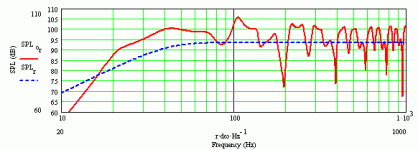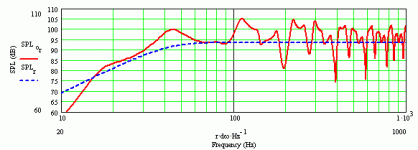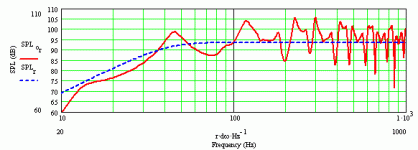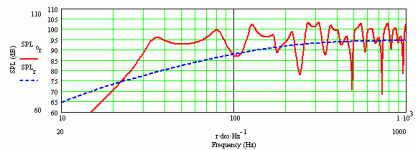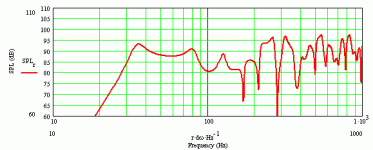dmason said:.......but I also perceive that there will be lost the throati-ness that comes with that extra reach of 5 cycles or so before the illustrated roll off of the "optimal" load, optimal being in quotation marks.
.......one of the amazing, almost alchemical bonuses of the whole BIB thing is the lower register has a presentation that is almost indistinguishable from dipole.......
Greets!
Happy 4th!
Yeah, from a purely technical POV, a slightly smaller Vb is statistically insignificant, but in-room you never know and if there's one thing that I've learned is that the lower I experimented with cab tuning and increased acoustic gain, the more life-like and extended the mids/highs sounded.
I'm not sure I understand the dipole reference though. I mean during my experimental years I didn't try them in the LF since it would have been a waste of time given the drivers and source material of the day and the lower you tune a corner loaded alignment, the more the room's modes are energized, the opposite of what a dipole theoretically does.
GM
I couldn't begin to explain, and I agree wholly with what you are saying, however, something in the way that bass and lower register information is propagated, along the ceiling, where there are no obstructions, ("not much furniture on the ceiling," TC) that this information is presented in such a way that it ~sounds very like dipole bass. Even stranger is the lack of room modes excitation, but not a lack of resonances, like true dipole.
When a friend of mine heard my BIB's, he mentioned how much the lower end reminded him of his speakers, the DarkStars I built for him. It was an interesting blind test, in a way. As to exactly why, -- ?
When a friend of mine heard my BIB's, he mentioned how much the lower end reminded him of his speakers, the DarkStars I built for him. It was an interesting blind test, in a way. As to exactly why, -- ?
Who knows? I certainly don't. Like Dan, I agree 100% technically it's the exact oposite of dipoles, but the sound in the lower registers is uncannily like them. I've never heard of anything quite like it before. Psycho-acoustic perhaps, but if so, it's pretty impressive. Whatever the real reason, it seems to work.
Most of the dimensions on the 'Zilla site that I suggest are deliberately as simple and small as I could get away with, without any series resitance applied, as you note. Going bigger could be very interesting -you reckon on doubling Vb in relatively 'dead' acoustics then Greg? I've been a bit over-cautious perhaps about the 1/2 space LF curves, which is daft of me, but there you have it.
Oh yeah, nearly forgot. I've been playing with their positions in the room. One that works well for me, is against the side walls, with moderate toe-in, pulled a few feet forward from the rear wall / corner. All rooms are different of course, but this has worked in a couple of rooms for me now, and seems useful if you happen to have a door right in the corner you'd like your cabinet to go.
Regards
Scott
Most of the dimensions on the 'Zilla site that I suggest are deliberately as simple and small as I could get away with, without any series resitance applied, as you note. Going bigger could be very interesting -you reckon on doubling Vb in relatively 'dead' acoustics then Greg? I've been a bit over-cautious perhaps about the 1/2 space LF curves, which is daft of me, but there you have it.
Oh yeah, nearly forgot. I've been playing with their positions in the room. One that works well for me, is against the side walls, with moderate toe-in, pulled a few feet forward from the rear wall / corner. All rooms are different of course, but this has worked in a couple of rooms for me now, and seems useful if you happen to have a door right in the corner you'd like your cabinet to go.
Regards
Scott
Hi,
Speaking of Vb, reading back on this post...:
http://www.diyaudio.com/forums/showthread.php?postid=877481#post877481
Seems that too small a Vb would have this type of sound/response for high Vas drivers like the B200. But is it the biggest factor, or are there other parameters in the T/S that would contribute to this type of response?
I've actually heard this type sound before in another blh using a driver not really designed for it, but I'm not sure what other parameters contribute to this response. Xmax, Q?. Thanks.
fred
Speaking of Vb, reading back on this post...:
http://www.diyaudio.com/forums/showthread.php?postid=877481#post877481
Seems that too small a Vb would have this type of sound/response for high Vas drivers like the B200. But is it the biggest factor, or are there other parameters in the T/S that would contribute to this type of response?
I've actually heard this type sound before in another blh using a driver not really designed for it, but I'm not sure what other parameters contribute to this response. Xmax, Q?. Thanks.
fred
Q isn't as important for horns in general as you might think. Have a look at Martin King's articles on horns at www.quarter-wave.com Unless you have a SET, DHT, very low DF PP or SS amp, a nice mid Q driver happens to suit the BIB best, but it's not overly critical. I've had excellent results out of the FF225K, which is one of the lowest Q FR drivers available.
Xmax again doesn't matter as much with horns as, say, a BR or a TL of some description. Look at the massive volumes you can get out of the traditional movie horns despite the miniscule displacemnt of most of the drivers loading them. Vas is really the critical factor here at least.
Quick demo. Here's a B200 BIB, courtesy of GM. Line length 169.5in Zdriver 34in. Sm=350in^2 (yes, you did read that 350in^2 bit correctly.)
Xmax again doesn't matter as much with horns as, say, a BR or a TL of some description. Look at the massive volumes you can get out of the traditional movie horns despite the miniscule displacemnt of most of the drivers loading them. Vas is really the critical factor here at least.
Quick demo. Here's a B200 BIB, courtesy of GM. Line length 169.5in Zdriver 34in. Sm=350in^2 (yes, you did read that 350in^2 bit correctly.)
Attachments
Hi All!,
thanks for the responses. Hopefully my room will welcome the slightly reduced BiB's as they are and not needing the extra 5l Vb to flatten its in-room response.
As source I'm using lossless audio-files with Foobar from my computer, in the near future a Squeezebox, so some eq is easily made.
As I have two pairs of 166-ESR's the bigger (2xVb) design with higher tunability is of much interest for a later project. Scott, could you please make the sims for a "bigger, bigger is better"
GM, thanks for taking time with thoughtful and technical correct answers, hope you don't mind me posting your "knee jerk" version. I simply got surprised when it vanished before my eyes.
thanks for the responses. Hopefully my room will welcome the slightly reduced BiB's as they are and not needing the extra 5l Vb to flatten its in-room response.
As source I'm using lossless audio-files with Foobar from my computer, in the near future a Squeezebox, so some eq is easily made.
As I have two pairs of 166-ESR's the bigger (2xVb) design with higher tunability is of much interest for a later project. Scott, could you please make the sims for a "bigger, bigger is better"
GM, thanks for taking time with thoughtful and technical correct answers, hope you don't mind me posting your "knee jerk" version. I simply got surprised when it vanished before my eyes.
Final B200 BIB box, with Vb halved again, and is now 1/4 of that Greg originally advised.
I hasten to add, I wouldn't advise trying these two smaller versions!
I'll run a sim of the ES-R enclosure with Vb doubled. The predicted FR will have a dip between 2 peaks below 100Hz. That doesn't mean it'll behave like that in real life of course -it probably won't.
I hasten to add, I wouldn't advise trying these two smaller versions!
I'll run a sim of the ES-R enclosure with Vb doubled. The predicted FR will have a dip between 2 peaks below 100Hz. That doesn't mean it'll behave like that in real life of course -it probably won't.
Attachments
Here's the ES-R box, with Vb doubled. This is why I tend to limit the sizes a bit -note the dip between two peaks, and the increased dip in the midbass on the sim. I suspect the value of these simulations actually decreases as Vb goes up, unless you add series resistance to restore the aparrant balance. I haven't looked an the in-room bit, so I'll check that as far as can be done in the existing sheet and post the predicted curve in the next post as well.
Attachments
1/4 space sim of the large ES-R enclosure, assuming them rammed against a rear wall. Actually, this is the plot assuming a BSC circuit in place. It flattens the LF out, relative to the midrange, and I reckon the extra LF boost you get from the corner should produce a similar result, albeit with greater efficiency. I believe Martin is working on a 1/8 space upgrade to the sheets, so hopefully we'll get confirmation before the year is out.
Of itself this is quite interesting though -look at that slow dip in the mid-bass that is characteristic of these big pipes. The uneven response Martin reckons is considerably over-estimated. Even when we get the 1/8 space worksheets, an upward firing mouth probably won't be acounted for in that upgrade, so I've had to fudge it a little, assuming a rearward firing mouth at the very top of the enclosure (well, half on the top, half above the top to be pedantic).
Of itself this is quite interesting though -look at that slow dip in the mid-bass that is characteristic of these big pipes. The uneven response Martin reckons is considerably over-estimated. Even when we get the 1/8 space worksheets, an upward firing mouth probably won't be acounted for in that upgrade, so I've had to fudge it a little, assuming a rearward firing mouth at the very top of the enclosure (well, half on the top, half above the top to be pedantic).
Attachments
Baffle step
I would like to ask, if in the sims presented for the BIB's the baffle step attenuation has been taken into acount.
Maybe it's written somewere, it's hard to read all the posts
- i do this for a week and haven't red not even half of them.
Thanks a lot
Greetings
Konstantinos
I would like to ask, if in the sims presented for the BIB's the baffle step attenuation has been taken into acount.
Maybe it's written somewere, it's hard to read all the posts
- i do this for a week and haven't red not even half of them.
Thanks a lot
Greetings
Konstantinos
You're welcome! (Hey, that's Greg's line!)
I'd hang fire on your dipoles. Not sure the 166 will be the best choice for them to be honest -not enough Xmax for that application IMO. Try the small BIB; if it works, well and good. If not, you can go for the larger variety.
BSC? Depends which you're refering to. The sims on the Zilla site? No. Deliberate choice. Because these are designed to be rammed into corners, baffle-step isn't much of an issue as the box is close to the room boundaries. If you find you need one, I'd suggest Martin's variable circuit detailed on www.quarter-wave.com to dial it in to your specific room. Much better than sugesting generic values.
Regards
Scott
I'd hang fire on your dipoles. Not sure the 166 will be the best choice for them to be honest -not enough Xmax for that application IMO. Try the small BIB; if it works, well and good. If not, you can go for the larger variety.
BSC? Depends which you're refering to. The sims on the Zilla site? No. Deliberate choice. Because these are designed to be rammed into corners, baffle-step isn't much of an issue as the box is close to the room boundaries. If you find you need one, I'd suggest Martin's variable circuit detailed on www.quarter-wave.com to dial it in to your specific room. Much better than sugesting generic values.
Regards
Scott
Scottmoose said:
BSC? Depends which you're refering to. The sims on the Zilla site? No. Deliberate choice. Because these are designed to be rammed into corners, baffle-step isn't much of an issue as the box is close to the room boundaries. If you find you need one, I'd suggest Martin's variable circuit detailed on www.quarter-wave.com to dial it in to your specific room. Much better than sugesting generic values.
Regards
Scott
Thank you very much. I'll build the ones for the 6,5'' Fostex. Because my woodworking skills are non existent, i must wait a week - until a friend can assist me.
Then we are going to measure them in my room (35m^2 - 350 sq.ft) with the Behringer ultracurve pro (how accurate is this is another question). And hear it of course.
If it needs a baffle, i ' m going to add one. About 70x70cm (28x28 inch) will help it going down to about 110-120Hz with the same slope as in the specsheet. I hope that the BIB/room will take over from there.
Best Regards
Konstantinos
Hi Scott,
Thanks for the very incisive reply. I see now that Vb is the biggest factor in that type of response as far as the post I referenced.
Looking at the 1/2 Vb simmed for the B200 there is a large dip in the midbass. And then going 1/4, the LF gets more truncated still. Although the lower midrange has just a tad more dip when having a larger Vb (the best balance, ie, Greg's sim), the BIB's placement/room dependent nature + other variables cited makes it less of an issue, if at all.
fred
Thanks for the very incisive reply. I see now that Vb is the biggest factor in that type of response as far as the post I referenced.
Looking at the 1/2 Vb simmed for the B200 there is a large dip in the midbass. And then going 1/4, the LF gets more truncated still. Although the lower midrange has just a tad more dip when having a larger Vb (the best balance, ie, Greg's sim), the BIB's placement/room dependent nature + other variables cited makes it less of an issue, if at all.
fred
The front of the baffle.
This is a question about the front edges of the baffle.
The front of the cab on the BIB seems to have a square edges.
(The edge that is created where the front meets the sides. One on the left side and one on the right)
So the question....
Should it be square or should it be rounded?
I built a pair (some years ago) of Lynn Olsen's Ariels and Lynn said to apply the router to the edges to round them over. I do recall they were, as per his specs very round.
So...To be round or to be square?
I'm using a 1 3/4 inch thick front baffle. (Maple) These is plenty of room to round them over.
I think it would look nice with a round over.
I thank you for your help and advise.
Phil
Santa Fe
West of the Pecos and East of the Rio Grande
(Not so Grand...Not much water this year)
This is a question about the front edges of the baffle.
The front of the cab on the BIB seems to have a square edges.
(The edge that is created where the front meets the sides. One on the left side and one on the right)
So the question....
Should it be square or should it be rounded?
I built a pair (some years ago) of Lynn Olsen's Ariels and Lynn said to apply the router to the edges to round them over. I do recall they were, as per his specs very round.
So...To be round or to be square?
I'm using a 1 3/4 inch thick front baffle. (Maple) These is plenty of room to round them over.
I think it would look nice with a round over.
I thank you for your help and advise.
Phil
Santa Fe
West of the Pecos and East of the Rio Grande
(Not so Grand...Not much water this year)
- Home
- Loudspeakers
- Full Range
- Terry Cain's BIB -why does it work and does anyone have those Fostex Craft Handbooks?
